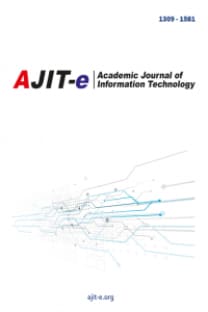An internet radio from Turkey as an example of community radio: Nor radyo
Türkiye'de Topluluk medyasına örnek olarak bir internet radyosu: Nor radyo
___
- Carpentier, N. & Rico L. & Jan S. (2001 July), Community Media Muting the Democratic Media Discourse? , The International Social Theory Consortium Second Annual Conference, Brighton, pp. 1-25.
- Deleuze, G. & Guattari, F., (1987) A Thousand Plateaus: Capitalism and Schizophrenia, Minneapolis: University of Minnisota Press.
- Downing, J. D. H. (2001) Radical Media Rebellious Communication and Social Movements , Sage.
- European Parliament. (2007). The State of Community Media in the European Union Report by KEA for the Committee on Culture and Education, Brussels: European Parliament.
- European Parliament. (2008). European Parliament Report on Community Media in Europe, Brussels.
- Hollander, E. (2002). Community Media and Online Communities: Toward a Theoretical and Methodological Framework. In N. W. Jankowski & O. Prehn (Eds.), Community Media in the Information Age: Perspectives and Prospects , (pp. 31-46). Cresskill NJ: Hampton Press.
- Jankowski, N. W. (2003). Community Media Research: A Quest for Theoretically-Grounded Models. The Public, Volume 10, 1, pp. 5-14.
- Jones, S. G. (1995). Understanding Community in the Information Age. In S. G. Jones (Ed.), CyberSociety; Computer -Mediated Communication and Community, (pp. 10-35). London: Sage.
- Lewis, P. (1993). Alternative Media in a Contemporary Social and Theoretical Context. In P. Lewis (Ed.), Alternative Media: Linking Global and Local, (pp. 15-25). Paris: Unesco.
- Milan, S. (2009). Four Steps to Community Media as a Development Tool. Development in Practice, Volume: 19, Numbers: 4-5, pp. 598-609.
- Morris, A. & Graeme M. (1998), Locality, Community and Nation. London: Hodder & Stoughton.
- Mouffe, C. (1997), The Return of the Political. London: Verso. Mouffe, C. (1999). Deliberative Democracy or Agonistic Pluralism?, Social Research, 66 (3), pp. 745-758.
- Possi, M. (2003). Community Media Defined in Nasanga,G. In The East Africa Media and Globalization: Defining the Public Interest (pp. 167-169). Kampala: Industrial Graphic System.
- Rennie, E. (2006), Community Media, A Global Introduction. New York: Rowman and Little Field Publishers, Inc.
- Saeed, S. (2009). Negotiating Power: Community Media, Democracy and the Public Sphere, Development in Practice, Volume 19, Numbers 45, pp. 466-478.
- Servaes, J. (1999), Communication for Development: One World, Multiple Cultures, Cresskill, New Jersey: Hampton Press.
- Tönnies, F. (1963), Community and Society, London: Harper and Row.
- Michael, T. (1985). Alternative Journalism, Alternative Media, Communication Resource, No: 7.
- www.norradyo.com
- Yayın Aralığı: 4
- Yayıncı: AKADEMİK BİLİŞİM ARAŞTIRMALARI DERNEĞİ
GPU Hızlandırmalı Veri Demetleme Algoritmalarının İncelenmesi
Nazire Merve ÇETİN, Murat HACIÖMEROĞLU
İnternet Haberciliğinde Yasadışı Göç Sorunu Ocak 2011-Nisan 2012
Sosyal medya ve internet teknolojisi ile yöndeşen televizyon yayıncılığı: Sosyal Tv
Ali Murat KIRIK, Murat Kazım KARAKUŞ
İnternet haberciliğinde yasadışı göç sorunu (Ocak 2011 - Nisan 2012)
An internet radio from Turkey as an example of community radio: Nor radyo
The Formation Of Green Buying Strategy On The Scope Of Consumer Decision Making Behavior
Sosyal Medya ve İnternet Teknolojisi İle Yöndeşen Televizyon Yayıncılğı: Sosyal TV
Ali Murat KIRIK, Murat Kazım KARAKUŞ
Vertebra lomber disklerde meydana gelen bozulmaların manyetik rezonans görüntüleme (mrg) ile analizi
Esra BUDAK ÇOBAN, Mehmet Recep BOZKURT
Türkiye’de Topluluk Medyasına Örnek Olarak Bir İnternet Radyosu: Nor Radyo
Vertebra Lomber Disklerde Meydana Gelen Bozulmaların Manyetik Rezonans Görüntüleme MRG ile Analizi
